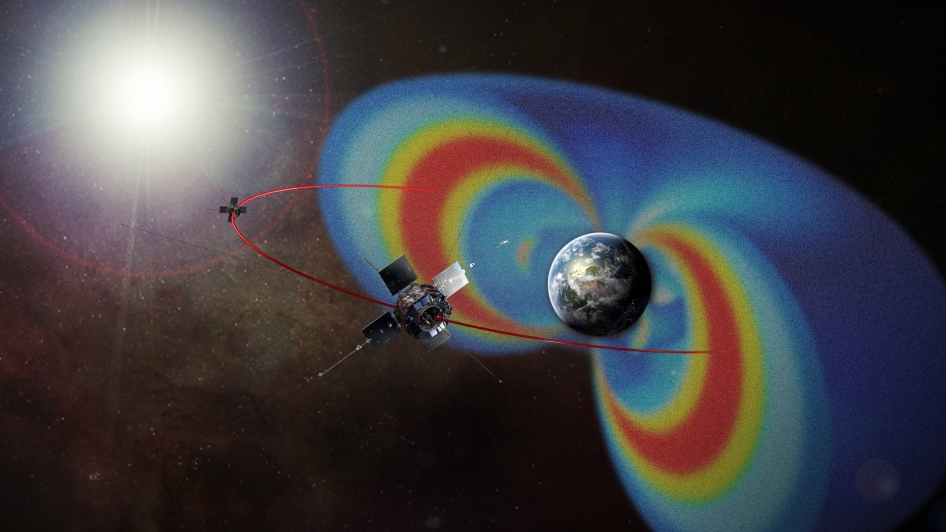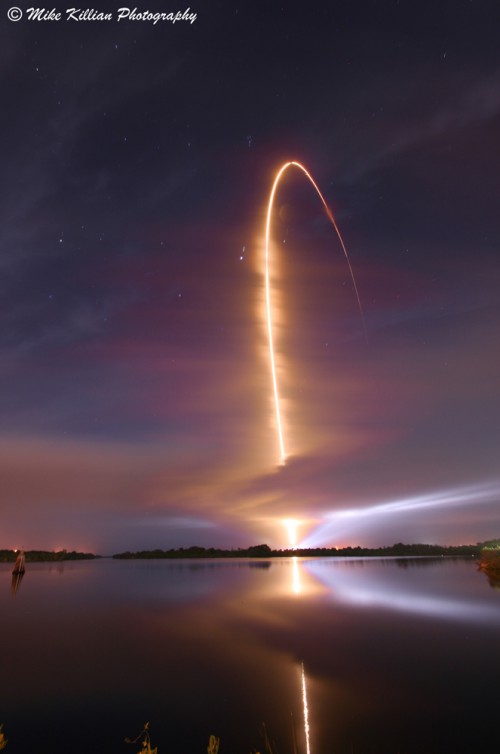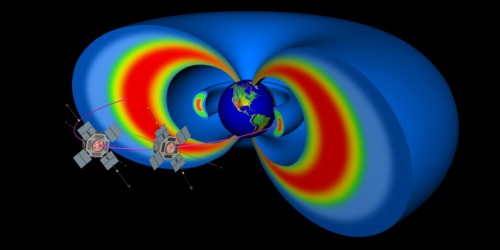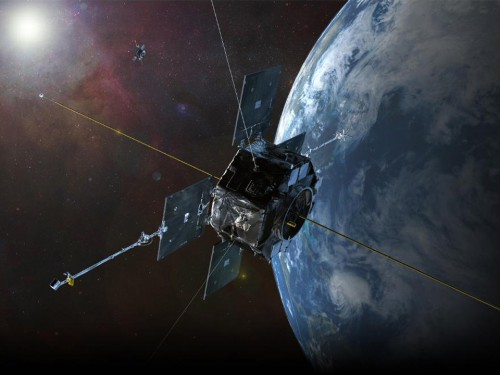
Image Caption and Credit: NASA
It’s been two years now since NASA launched their twin Van Allen probes to explore the mysteries of Earth’s hazardous radiation belts and study the Sun’s influence on space weather phenomenon in Earth’s near-space environment. In the time since, the mission has been declared an overwhelming success, making numerous discoveries and answering many questions that have baffled scientists for decades. Now, with the mission surpassing its two-year expected time frame, both spacecraft are still going strong and are expected to continue delivering more ground-breaking science for years to come.
“Not only has the Van Allen Probes mission met its requirements for mission success, it has exceeded them,” said NASA’s Mona Kessel, Van Allen Probes program scientist. “This is where we see how all of the dedication and hard work from men and women across NASA, APL, all of the instrument teams, and our other partners that created the mission has really paid off. Already, we’ve made a number of discoveries and findings that are changing how scientists understand these fascinating regions of near-Earth space.”

Built and operated by the Johns Hopkins University Applied Physics Laboratory (APL) and launched into darkness atop a ULA Atlas-V rocket from Cape Canaveral, Fla., on Aug. 30, 2012, the probes wasted no time getting to work studying this harsh region of super-energetic, charged particles surrounding our world. By studying the belts on various scales of space and time, the probes are helping scientists to understand how the Sun influences space weather, shedding light on the fundamental processes that generate hazardous space weather, which can seriously damage most spacecraft and hurt astronauts, or worst. So, while most spacecraft try to avoid the belts, the Van Allen probes aimed straight for them.
“The spacecraft were very well designed and specifically hardened to be protected – both physically and electronically – against highly-charged particles,” said Kessel. “We’re seeing that they’re holding up very well in this harsh environment, which would damage and disable most spacecraft.”
Flying in nearly identical eccentric orbits, the twin spacecraft cover the entire radiation belt region, and within days of launch they had already discovered the existence of a third transient radiation belt. High-resolution observations, made by the Relativistic Electron Proton Telescope (REPT) instrument, which is part of the Energetic Particle, Composition, and Thermal Plasma Suite (ECT) aboard the Van Allen Probes, revealed there can be three distinct, long-lasting belt structures with the emergence of a second empty slot region, or space, in between.
“This is the first time we have had such high-resolution instruments look at time, space and energy together in the outer belt,” said Daniel Baker, lead author of the study and REPT instrument lead at the Laboratory for Atmospheric and Space Physics (LASP) at the University of Colorado in Boulder. “Previous observations of the outer radiation belt only resolved it as a single blurry element. When we turned REPT on just two days after launch, a powerful electron acceleration event was already in progress, and we clearly saw the new belt and new slot between it and the outer belt.”
“This finding was completely unexpected,” said Barry Mauk, Van Allen Probes project scientist at APL. “No one predicted the existence of structure in the outer belt.”
One of the mission’s top priorities has been to understand how particles in the belts are accelerated to near the speed of light, and in the summer of 2013 the probes discovered a massive natural particle accelerator in the heart of the belts themselves. By taking simultaneous measurements with their instruments, the probes revealed that electromagnetic waves coursing through the belts kick particles to ever-faster speeds, much like a well-timed push on a moving swing. The process, known as the local acceleration theory, is similar to the way warm ocean water at Earth’s equatorial regions can fuel hurricanes and tropical storms, and it gives the two main radiation belts their distinctive doughnut-shaped look.

Credit: JHU/APL, NASA
“This is one of the most highly anticipated and exciting results from the Van Allen Probes,” said David Sibeck, Van Allen Probes project scientist at NASA’s Goddard Space Flight Center in Greenbelt, Md. “It goes to the heart of why we launched the mission.”
When the outer belt swells, it expands to include the orbits of the International Space Station and many of the 800 satellites our society depends on for GPS, weather forecasting, communications, and more. Understanding this process, and knowing the location of the acceleration within the radiation belts, will help scientists improve predictions of space weather, which in turn means keeping satellites, spacecraft, and astronauts out of harm’s way.
More recently, in March 2014, scientists discovered a new, persistent structure of high-energy electrons in the inner radiation belt. The probes showed that the pattern, which resemble slanted zebra stripes, is produced by the slow rotation of Earth, something that was previously assumed impossible because scientists believed that increased solar wind activity was the primary force behind any structure in Earth’s radiation belts.
“The RBSPICE instrument has remarkably fine resolution and so it was able to bring into focus a phenomena that we previously didn’t even know existed,” said Sibeck. “Better yet, we have a great team of scientists to take advantage of these unprecedented observations: We couldn’t have interpreted this data without analysis from strong theoreticians.”

Image Credit: NASA
Ultimately, the knowledge obtained from the probes will help scientists to better forecast space weather, which in turn will help in developing new technologies to avoid the very real threat of a severe space weather event crippling our modern day dependence on space-based technology. To put things in perspective, the Quebec blackout of March 13, 1989, which was caused by a major geomagnetic storm, caused a $6 billion loss to the Canadian economy. The most powerful solar flare in the last 500 years occurred on Sept. 2, 1859, and if that same storm were to hit Earth right now it could cost $30 billion a day to the U.S. electrical power grid, and up to $70 billion to the satellite industry.
One of the most challenging obstacles for any long-duration deep space human exploration missions, such as missions to asteroids and Mars proposed for the SLS/Orion program by NASA, is the threat of solar storms and lethal doses of radiation. A solar flare observed on Aug. 4, 1972, was so powerful that, by some estimates, even an astronaut in a spacesuit would have received a lethal dose of radiation. In the future, being able to predict such events will help keep astronauts out of harm’s way, as opposed to not understanding how and why such phenomenon occur and unknowingly sentencing someone to a lonely death hundreds, if not thousands, of miles from home. The Van Allen probes will continue to shed light on the processes that cause these phenomenon, which will ultimately aid in ensuring the safety of astronauts embarking on those missions starting in the early 2020s.
“The Van Allen Probes mission has given us the means to validate theories about plasma physics and the acceleration processes going on inside the belts,” adds Mauk. “They also have shown us new structures and features in this region of space, the existence of which we had never suspected. It has been a very illuminating two years, and we look forward to many more with these remarkable spacecraft.”
Want to keep up-to-date with all things space? Be sure to “Like” AmericaSpace on Facebook and follow us on Twitter: @AmericaSpace




Walking on the moon…. meant be cooked like an eggs…. while in hollywood it could be happened !!